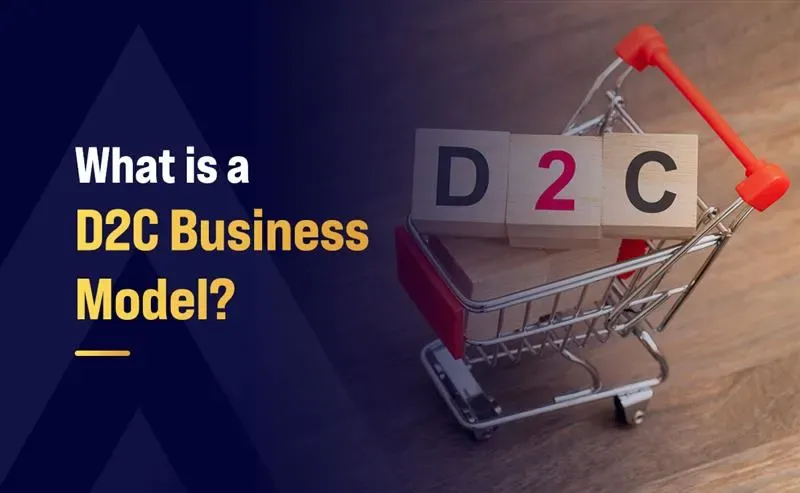What is a D2C Business Model?

The D2C, or direct-to-consumer, business model has reshaped the retail industry. It fosters a closer and more personal link between brands and their customers. The D2C model not only allows for greater profit margins but also fosters a closer, more personalized relationship with customers.
By bypassing traditional retail channels, D2C brands establish a direct link with customers, resulting in improved profit margins, tailored experiences, and stronger customer relationships. Rising per capita earnings are propelling India's D2C market, which is projected to triple to $61.3 billion by FY27.
This article will explore what are direct-to-consumer (D2C) business models. It will also dive into the benefits of the models, the challenges they face in the modern market, and the types of D2C models available in the industry.
What is the direct-to-consumer (D2C) model?

D2C, or direct-to-consumer, refers to a setup where brands bypass traditional retail channels to sell directly to consumers. This enables brands to craft a compelling brand story and maintain control over pricing and product presentation.
The rise of eCommerce business and social media has accelerated the adoption of this model, enabling D2C brands to capture a large share of the market. These brands are prospering by aligning with consumers' growing demands for both convenience and openness from brands.
This model has transformed industries by reducing costs and improving customer experience to enable better brand control. The D2C market in India is on a growth trajectory, expanding at a 38% CAGR, and is expected to create 10 million retail jobs by 2027.
Benefits of a Direct-to-Consumer (D2C) Business Model
Embracing a D2C model offers several unique advantages that help brands succeed in a competitive market.
Enhanced Profitability and Margin Control:
The D2C model empowers brands with direct control over them profit margins by bypassing intermediaries like wholesalers and retailers. This eliminates additional markups and distribution fees, allowing brands to retain a larger share of revenue from each sale.
This financial advantage offers flexibility to strategically price products, making them competitive or positioning them as premium offerings, and reinvest profits into critical areas such as innovation, logistics, customer service, and digital platforms.
By maximizing profits and reinvesting strategically, brands can enhance their online shopping experience, improve delivery efficiency, and develop tailored loyalty programs. Over time, this approach fosters sustainable growth, financial stability, and stronger customer retention, ensuring businesses thrive without reliance on external partners.
Access to More Targeted Data:
One of the primary benefits of the D2C model is the ability to gather critical, firsthand insights from customers. Unlike traditional retail models, where consumer data is often aggregated and generalized by third-party retailers, D2C brands can collect detailed insights directly from their customers.
This data includes insights like demographics, buying behaviors, individual preferences, and even product performance feedback.
With this comprehensive data, D2C brands can fine-tune their marketing efforts, adjust product offerings, and create tailored customer experiences. For example, brands can use customer data to offer targeted discounts, create personalized product recommendations, or design marketing campaigns tailored to specific customer segments.
The capability to categorize customers based on their behaviors and preferences enables D2C brands to optimize marketing expenses and strengthen audience connections. This data-driven approach gives brands a significant edge in a crowded marketplace.
A Higher Degree of Personalization:
Personalization is a major advantage of the D2C model, allowing brands to offer more tailored experiences to their customers. Since D2C brands interact directly with their audience, they can collect continuous feedback and respond by adapting their product offerings to meet customer preferences.
This customer-centric approach allows for a higher degree of customization, whether through personalized product recommendations, custom packaging, or unique product variations based on specific customer needs.
Moreover, this model allows brands to engage with customers on a deeper level. They can gather insights from customer interactions via social media, email surveys, or website tracking to continually refine their offerings.
Personalization extends beyond product customization; it also includes creating a personalized brand experience that speaks directly to the customer’s values and desires. This approach not only boosts customer loyalty but also reduces returns and encourages repeat purchases, as customers feel more valued and understood.
More Room for Product Testing:
The D2C model also provides greater room for experimentation, allowing brands to test new products, services, and concepts more efficiently. Because D2C brands are in direct contact with their customers, they can quickly gather real-time feedback on new product releases, packaging changes, or service improvements.
This makes the D2C model ideal for companies that want to innovate without waiting for approval from third-party retailers.
For instance, D2C brands can use A/B testing to see how customers respond to different designs, features, or marketing messages, and adjust as needed. Brands can also conduct limited-time product releases or exclusive offers to gauge customer demand and fine-tune their offerings before launching full-scale.
This agility is essential for staying competitive in fast-moving markets, as companies can quickly respond to trends or shifts in consumer preferences.
Product testing also helps D2C brands reduce waste, as they can produce smaller quantities of products initially and adjust based on customer response. This minimizes the risk associated with launching new products and ensures that resources are spent efficiently.
Improved Customer Relationships:
Direct interaction with customers not only helps D2C brands gather data but also fosters stronger, more meaningful relationships.
By selling directly through their own channels, brands have more opportunities to engage with customers, resolve issues quickly, and provide tailored recommendations.
Building a direct relationship with customers makes it easier to earn their trust and create brand loyalty, as customers appreciate transparency and personalized service.
In addition, D2C brands can improve the customer journey by offering responsive support across various channels, including chatbots, social media, and email.
The ability to offer personalized customer service not only improves the customer experience but also creates a sense of brand loyalty that traditional retail models may not be able to match.
Faster Response to Market Changes:
Because D2C brands maintain complete control over their operations, they can respond to market changes more quickly.
Whether it's a shift in consumer preferences, new market trends, or the introduction of a competitor’s product, D2C brands can pivot faster than traditional retail companies, which may be bound by the constraints of wholesale agreements or retailer relationships.
For instance, a D2C brand can quickly update its marketing strategies based on consumer feedback, launch new products in response to emerging trends, or adjust pricing without waiting for approvals. This speed and agility allow D2C brands to stay ahead of the competition and maintain relevance in the marketplace.
Challenges of a direct-to-consumer business model
While a D2C model empowers brands on a lot of different levels, it also presents unique challenges. Below mentioned are a few key challenges that companies often face when shifting to a direct-to-consumer model:
Customer Acquisition:
Since D2C brands lack the visibility retailers provide, they often struggle with building initial customer awareness. New brands in the market must start by creating trust and recognition online.
To succeed, D2C brands must make significant investments in digital marketing tactics, including SEO, social platforms, and paid advertising.
For new brands, the cost and complexity of acquiring customers independently can be challenging. Competition is intense in a crowded market where even established brands like Nike and Adidas are moving towards the D2C model.
Hence, D2C brands must often work even harder than traditional retail for brand visibility in order to drive traffic to their own platforms.
Product Distribution:
Efficient distribution is crucial in the D2C business model, as timely delivery influences consumer satisfaction. However, managing logistics independently is a major hurdle for D2C brands.
Unlike traditional retail, where logistics are often handled by wholesalers, D2C brands are responsible for every aspect of product delivery, from warehouse management to last-mile logistics.
The modern customer expects swift and accurate delivery, often comparable to Amazon’s two-day shipping. To meet these high expectations, D2C brands either need robust in-house warehousing and logistics capabilities or reliable partnerships with third-party logistics (3PL) providers.
Each choice involves distinct costs and operational complexities, making logistics management a crucial but challenging aspect of D2C operations.
Scalability:
As D2C businesses grow, scaling operations sustainably becomes increasingly complex. Unlike traditional businesses that rely on partnerships with retailers for scaling, D2C brands often handle every aspect of their business internally, from customer service to marketing and product management, which requires significant resources.
Ensuring personalized customer experiences at scale can strain budgets. The complexity of this approach calls for the use of automation tools and strategic resource management.
Scaling up without sacrificing quality or brand identity is difficult, especially when D2C enterprises must compete with established brands that have more resources and smoother operations.
Types of D2C Business Models with Examples
A lot of D2C models are emerging and providing firms with unique opportunities to engage customers and scale effectively. D2C companies have the flexibility to choose among different business models based on their audience, market demands, and growth strategies.
Here, we explore three prominent types along with D2C business examples that showcase their effectiveness.
Direct Selling
Direct selling is one of the oldest forms of D2C business, where companies engage with customers directly through independent representatives. It operates through two key approaches:
Door-to-Door Selling:
In this traditional method, sales representatives personally visit customers' homes to sell products. It emphasizes personalized interactions and builds trust.
Example: Home appliance companies and vacuum cleaner brands often use this method, where representatives demonstrate products in the customer's environment.
Multi-Level Marketing (MLM):
This approach involves recruiting independent sellers who not only sell products but also build teams of sellers under them. These sellers earn commissions based on their sales and the sales of their recruits.
Examples:
- Tupperware: Known for its kitchen storage solutions.
- Amway: A pioneer in health, wellness, and beauty product marketing.
Pure-Play Digital
This model relies entirely on digital platforms like websites, mobile apps, and social media to sell and market products. It caters to modern consumers who prefer the convenience of online shopping.
Features:
- Cost-effective for startups and small brands due to minimal overhead costs.
- Enables precise targeting through data-driven marketing strategies.
- Allows full control over the brand’s digital presence and customer data.
Examples:
- Nykaa: A beauty and wellness brand that gained prominence by offering a wide range of products through its website and app.
- Bewakoof: A youth-focused apparel brand that built its success on social media and its user-friendly website.
Marketplace Only
This model uses established e-commerce platforms as intermediaries to sell products. Manufacturers register as sellers and leverage the platform’s logistics, marketing, and customer base.
Advantages:
- Access to millions of potential customers without significant infrastructure investment.
- Quick market entry, especially for local or smaller brands.
- Offers scalability and ease of operation.
Examples:
- Local artisans and small brands: Platforms like Amazon and Flipkart provide an avenue for small-scale sellers, such as handmade jewelry brands or regional snack producers, to reach a wider audience.
Hybrid Model
The hybrid model combines the advantages of both marketplaces and direct channels, giving brands a dual approach to reach customers. Brands sell their products on popular e-commerce platforms while maintaining their independent websites or platforms to build direct relationships with customers.
Why Hybrid Works:
- Leverages the vast reach of marketplaces while retaining the brand’s identity through its own channels.
- Diversifies revenue streams, reducing dependency on any single channel.
- Ensures better customer engagement through personalized marketing on direct platforms.
Examples:
- MamaEarth: A personal care brand selling on Amazon and Flipkart while maintaining a robust direct sales channel.
- Licious: An online meat delivery brand that combines its direct website/app orders with marketplace presence to maximize its reach.
- Sugar Cosmetics: Uses its app and stores alongside partnerships with third-party platforms.
Omnichannel D2C Model
The omnichannel model focuses on creating a seamless customer experience by integrating all platforms (both physical and digital) into a unified strategy. It combines physical retail stores with digital tools like e-commerce websites and social media platforms.
Key Aspects:
- Heavy investment in tools like CRM (Customer Relationship Management) and ERP (Enterprise Resource Planning) to manage customer data and operations.
- Enhances customer experiences by providing both in-store and online purchase options.
- Builds brand trust through cohesive communication across all platforms.
Example:
- Titan: India’s leading watch and jewelry brand. Titan ensures uniformity in its customer interactions through retail stores, online platforms, and apps, creating an all-around superior shopping journey.
D2C Packaging: The Key to Branding

The packaging of a product is a crucial first touchpoint and often serves as the main branding vehicle for D2C companies. With no traditional retail spaces to showcase products, D2C brands depend heavily on packaging to capture attention, share values, and ultimately turn a single transaction into a loyal customer relationship.
Packaging serves as a customer’s first tangible experience with a D2C product. Effective packaging reflects a brand’s values, personality, and story, transforming it into a meaningful experience beyond mere aesthetics.
In a competitive D2C space, packaging differentiates brands. For example, from eco-friendly materials to premium aesthetics, every decision regarding packaging attracts a totally niche audience. Personalized packaging, such as custom messages, further deepens the brand narrative, resonating with customer values.
Indian packaging services also offer affordable yet premium packaging options, balancing aesthetics and cost-effectiveness for emerging D2C brands. Here are a few growing trends in D2C packaging:
- Minimalism: Clean, simple designs appeal to modern, young consumers.
- Interactive, Shareable Designs: Creative elements encourage social sharing.
- Beyond Recycling: Sustainable designs focus on zero waste and lifecycle impact.
- Localized Designs: Cultural elements in packaging foster a deeper customer connection.
FAQs:
Q1. What's the difference between B2C and D2C?
Ans: B2C (business-to-consumer) refers to traditional retail, where brands sell products to consumers through third-party retailers or marketplaces, like a store or online platform. D2C, or direct-to-consumer, on the other hand, eliminates intermediaries, allowing brands to sell directly through their own websites or social media.
Q2. Is Amazon a D2C or B2C?
Ans: Amazon serves as a marketplace where multiple brands can sell products to consumers. While Amazon has its own branded products, it primarily operates as an intermediary between brands and consumers. This differentiates it from D2C business examples that sell directly to customers without a third-party platform.
Q3. What is an example of a D2C model?
Ans: An example of a D2C model is Warby Parker, an eyewear brand that sells glasses directly to customers via its own website and retail stores. By avoiding traditional retail channels, Warby Parker offers competitive pricing and a unique customer experience, including features like home try-on kits and virtual try-ons.
Q4. What is a D2C strategy?
Ans: A D2C strategy is a business approach where a brand directly sells products to consumers through its own channels, such as a dedicated website.
This strategy focuses on building strong brand-customer relationships, leveraging customer data to personalize marketing, and often emphasizes unique brand packaging and experiences to drive customer loyalty and engagement.
Summing Up
As D2C marketing along with the industry continues to grow, understanding the benefits, challenges, and various models of D2C businesses is key to navigating this dynamic landscape. Whether through hybrid, subscription, or pure eCommerce models, D2C brands are leveraging innovative strategies to meet evolving consumer expectations.
By prioritizing customer-centric strategies, including memorable packaging and smart marketing, D2C brands are setting themselves up to thrive in a crowded marketplace.





